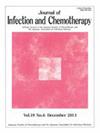慢性乙型肝炎病毒感染母亲的早产儿免疫预防的有效性:一项回顾性研究
IF 1.5
4区 医学
Q3 INFECTIOUS DISEASES
引用次数: 0
摘要
背景:乙肝病毒(HBV)感染母亲所生早产儿免疫预防的有效性尚不清楚。本研究旨在探讨免疫预防在早产儿中的有效性。方法纳入2016年1月1日至2018年12月31日期间由hbv感染母亲分娩的婴儿,早产儿在出生后立即接种乙型肝炎疫苗,1、2和7个月,足月婴儿在出生后立即接种疫苗,1和6个月接种疫苗。所有婴儿随访至24个月。通过比较HBV标志物的动态变化分析免疫预防对早产儿的效果,并采用多因素回归分析探讨相关因素。结果在研究期间(2016-2018年),共纳入2238例婴儿,其中早产儿175例,足月婴儿2063例。7-12月龄和24月龄组间HBsAb浓度差异无统计学意义(P >;0.05),但早产儿组浓度低于足月组。1分钟Apgar评分是7-12个月HBsAb中高反应的预测因子(OR 2.687, P = 0.027)。结论按照“0-1-2-7″”方案接种hbv感染母亲分娩的早产儿shbsab浓度与足月婴儿相似,结果良好。1分钟Apgar评分可用于预测完成免疫预防后7-12月龄早产儿HBsAb水平。本文章由计算机程序翻译,如有差异,请以英文原文为准。
Effectiveness of immunoprophylaxis for preterm infants of mothers having chronic hepatitis B virus infection: A retrospective study
Background
The effectiveness of immunoprophylaxis for preterm infants delivered by hepatitis B virus(HBV)-infected mothers remains unclear. This study aimed to investigate the effectiveness of immunoprophylaxis in preterm infants.
Methods
Infants delivered by HBV-infected mothers between January 1, 2016 and December 31, 2018 were enrolled, Preterm infants received hepatitis B vaccine immediately after birth and at one, two and seven months while full-term infants received vaccine immediately after birth and at one and six months. All infants were followed utill 24 months. Effectiveness of immunoprophylaxis in preterm infants was analyzed by comparing the dynamics of HBV markers and responsible factors were investigated using multivariate regression analysis.
Results
During the study period (2016–2018), 2238 infants were enrolled, including 175 preterm infants and 2063 full-term infants. The differences in the HBsAb concentration between groups were not statistically significant at 7–12 and 24 months of age (P > 0.05), but the concentration in the preterm group were lower relative to the full-term group. Apgar score at 1 min was a predictor of medium-to-high response of HBsAb at 7–12 month (OR 2.687, P = 0.027).
Conclusions
HBsAb concentration in preterm infants delivered by HBV-infected mothers who were vaccinated following the "0-1-2-7″ protocol were similar to those in full-term infants, thereby indicating good outcomes. One-minute Apgar score could be used to predict HBsAb levels in preterm infants at 7–12 months of age after completion of the immunoprophylaxis.
求助全文
通过发布文献求助,成功后即可免费获取论文全文。
去求助
来源期刊

Journal of Infection and Chemotherapy
INFECTIOUS DISEASES-PHARMACOLOGY & PHARMACY
CiteScore
4.10
自引率
4.50%
发文量
303
审稿时长
47 days
期刊介绍:
The Journal of Infection and Chemotherapy (JIC) — official journal of the Japanese Society of Chemotherapy and The Japanese Association for Infectious Diseases — welcomes original papers, laboratory or clinical, as well as case reports, notes, committee reports, surveillance and guidelines from all parts of the world on all aspects of chemotherapy, covering the pathogenesis, diagnosis, treatment, and control of infection, including treatment with anticancer drugs. Experimental studies on animal models and pharmacokinetics, and reports on epidemiology and clinical trials are particularly welcome.
 求助内容:
求助内容: 应助结果提醒方式:
应助结果提醒方式:


